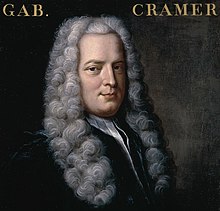Gabriel Cramer
Gabriel Cramer | |
|---|---|
 Gabriel Cramer (1704-1752). Portrait by Robert Gardelle, year unknown. | |
| Born | 31 July 1704 |
| Died | 4 January 1752 (age 47) |
| Nationality | Genevan |
| Alma mater | University of Geneva |
| Known for | Cramer's rule Cramer's theorem for algebraic curves Cramer's paradox |
| Scientific career | |
| Fields | Mathematics and physics |
| Institutions | University of Geneva |
Gabriel Cramer (French: [kʁamɛʁ]; 31 July 1704 – 4 January 1752) was a Genevan mathematician. He was the son of physician Jean Cramer and Anne Mallet Cramer.
Biography[edit]
Cramer showed promise in mathematics from an early age. At 18 he received his doctorate and at 20 he was co-chair[1] of mathematics at the University of Geneva.
In 1728 he proposed a solution to the St. Petersburg Paradox that came very close to the concept of expected utility theory given ten years later by Daniel Bernoulli.
He published his best-known work in his forties. This included his treatise on algebraic curves (1750). It contains the earliest demonstration that a curve of the n-th degree is determined by n(n + 3)/2 points on it, in general position. (See Cramer's theorem (algebraic curves).) This led to the misconception that is Cramer's paradox, concerning the number of intersections of two curves compared to the number of points that determine a curve.
He edited the works of the two elder Bernoullis, and wrote on the physical cause of the spheroidal shape of the planets and the motion of their apsides (1730), and on Newton's treatment of cubic curves (1746).
In 1750 he published Cramer's rule, giving a general formula for the solution for any unknown in a linear equation system having a unique solution, in terms of determinants implied by the system. This rule is still standard.
He did extensive travel throughout Europe in the late 1730s, which greatly influenced his works in mathematics. He died in 1752 at Bagnols-sur-Cèze while traveling in southern France to restore his health.
Selected works[edit]

- Quelle est la cause de la figure elliptique des planètes et de la mobilité de leur aphélies?, Geneva, 1730
- Introduction à l'analyse des lignes courbes algébriques at Google Books. Geneva: Frères Cramer & Cl. Philibert, 1750
See also[edit]
References[edit]
- "Gabriel Cramer", in Rousseau et les savants genevois, p. 29 (in French)
- W. W. Rouse Ball, A Short Account of the History of Mathematics, (4th Edition, 1908)
- Isaac Benguigui, Gabriel Cramer : illustre mathématicien, 1704–1752, Genève, Cramer & Cie, 1998 (in French)
- O'Connor, John J.; Robertson, Edmund F., "Gabriel Cramer", MacTutor History of Mathematics Archive, University of St Andrews
- ^ He did not get the chair of philosophy he had been a candidate for; but the University of Geneva was so impressed by him that it created a chair of mathematics for him and for his friend Jean-Louis Calandrini; the two alternated as chairs.
- (in German) Johann Christoph Strodtmann, « Geschichte des Herrn Gabriel Cramer », in Das neue gelehrte Europa […], 4th part, Meissner, 1754 Also digitized by e-rara.ch
External links[edit]
 Media related to Gabriel Cramer at Wikimedia Commons
Media related to Gabriel Cramer at Wikimedia Commons- O'Connor, John J.; Robertson, Edmund F., "Gabriel Cramer", MacTutor History of Mathematics Archive, University of St Andrews
